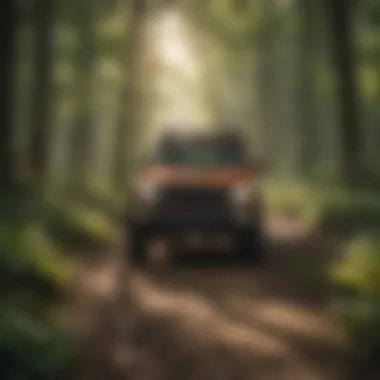Discover Indiana's Off-Road Trails: Your Ultimate Guide


Intro
Exploring off-road trails in Indiana serves as an exhilarating gateway for outdoor enthusiasts. The state is known for its lush landscapes, rich biodiversity, and diverse terrains that cater to various skill levels. From rugged paths winding through the Hoosier National Forest to smoother routes in state parks, Indiana boasts an array of options for both beginners and seasoned adventurers alike.
As we delve into the heart of Indiana's off-road experience, it is essential to understand what makes these trails not only a source of recreation but also vital components of the ecosystem. This guide will illuminate the unique features of these trails, accessibility considerations, and best practices that promote conservation and responsible usage.
Ultimately, by encouraging sustainable practices, we can help ensure that these natural wonders remain pristine for future generations. Embracing these ideals allows us to enjoy the beauty of Indiana’s landscapes while recognizing the ecological significance of these trails and the flora and fauna that inhabit them.
Prelims to Off-Road Trails in Indiana
Exploring Indiana's off-road trails is not just about the thrill of adventure. These trails offer a unique window into the natural beauty and diverse ecosystems the state has to offer, making them an essential part of Indiana's recreational landscape. As you traverse these paths, you're not just engaging in a pastime; you're also forging a connection with nature that can deepen one's appreciation for the environment.
Having a clear understanding of off-road trails in Indiana can help enthusiasts and novices alike make informed decisions about where to ride and how to do it responsibly.
Significance of Off-Roading
Off-roading has established itself as a popular activity, attracting those looking for a blend of excitement and escape. The significance of off-roading extends beyond mere enjoyment. It plays a role in fostering community, promoting outdoor activities, and even supporting local economies. The trails, when used responsibly, can be a source of recreation for families and friends, providing a setting for bonding and adventure that’s hard to replicate elsewhere.
In Indiana, off-roading contributes to the state's cultural tapestry. It's common to find families gathering for weekend excursions, exploring trails together and sharing stories of their experiences.
Additionally, off-roading encourages individuals to become stewards of nature. Many trail users become advocates for protecting the very ecosystems they enjoy. This connection can lead to greater understanding and appreciation of local flora and fauna, which is essential in today's world where natural habitats are under constant threat.
Overview of Indiana's Natural Terrain
Indiana's landscape is diverse, ranging from rolling hills to dense forests, offering a variety of terrains that off-road enthusiasts can navigate. The state features an assortment of terrains conducive to different off-roading experiences:
- Forested Areas: The Hoosier National Forest is a prime example where canopies of trees provide shade while facilitating spectacular views of the changing seasons.
- Hilly Regions: The rugged terrain found in southern Indiana challenges adventurers while rewarding them with breathtaking vistas.
- Wetlands and Marshes: These environments can offer a different form of off-roading, where riders might need to traverse waterlogged paths requiring specific skills and vehicles.
Understanding these natural features will enhance your experience on the trails. Being aware of what each terrain entails allows off-roaders to prepare adequately for the journey, ensuring safety and enjoyment. As a result, Indiana's trails not only serve as recreational spaces but also as classrooms for nature appreciation, challenging enthusiasts to respect and protect these natural wonders.
Types of Off-Road Trails
Understanding the various types of off-road trails in Indiana is crucial for outdoor enthusiasts looking to immerse themselves in the thrills that nature offers. Each trail type caters to different vehicles and riding styles, which allows both novices and seasoned adventurers to find their niche. The significance lies not just in the ride; it's about connecting with diverse landscapes, appreciating the challenges they present, and understanding the unique flora and fauna that inhabit these terrains. Whether zooming through muddy paths or navigating rocky inclines, each experience offers something distinct.
ATV Trails
All-Terrain Vehicles (ATVs) have gained enormous popularity in Indiana, partly due to the accessibility and diversity of the trails available. Indiana boasts numerous designated ATV trails, many of which can be found in places like the Hoosier National Forest and the Redbird State Recreation Area. These paths are often well-marked and vary in difficulty, making them suitable for riders of all skill levels.
Riding an ATV on these trails not only provides a fun-filled adventure but also gives a chance to witness the stunning visuals of Indiana’s landscape up close, from cascading streams to dense thickets. However, one must consider vehicle specifications, and stay informed about local regulations concerning ATV usage in these areas.
Motorcycle Trails
Motorcycle enthusiasts will find Indiana a gem when it comes to off-road terrains. There are specialized trails that allow for dirt bikes and dual-sport motorcycles. These trails often incorporate a blend of challenges, with twists and turns that require sharp focus and skill. The sound of engines and the rush of wind create an exhilarating atmosphere that attracts riders from near and far.
Many motorcycle trails are surrounded by breathtaking scenery, meaning that it’s not just about the ride, but also about experiencing the natural beauty of Indiana. It's essential for motorcyclists to be familiar with the terrain they are riding on, as some paths may be more demanding than others. Conditioning and knowing the bike's capabilities can enhance the experience immensely.
4x4 Trails
For those who prefer off-roading in trucks or SUVs, Indiana offers 4x4 trails that challenge both vehicle and driver. These trails are often rugged, featuring obstacles like steep inclines, mud pits, and tight turns. Off-roading with a 4x4 vehicle allows for a different kind of adventure. It is not just an encouragement to traverse difficult paths, but an opportunity to bond with fellow off-roaders, share stories, and perhaps, tackle challenges together.
Interestingly, these trails often require specific modifications to the vehicle for optimal performance. Tire selection and vehicle lift kits can play essential roles in the overall success of navigating these trails.
"Exploring the off-road trails in Indiana allows adventurers to connect with nature while pushing their skills and vehicles to new heights. This synergy between person and machine amid stunning landscapes is something every enthusiast should experience."
In summary, each type of off-road trail in Indiana provides distinct experiences, catering to the preferences of different outdoor enthusiasts. From the thrilling speeds of ATV trails, through dirt bikes with the motorcycles, to the challenges presented by 4x4 trails, the diversity is immense. Thus, these varied pathways allow riders to find joy and adventure tailored to their interests.
Popular Off-Road Trails in Indiana
When it comes to off-roading, Indiana packs a punch with its variety of trails that cater to numerous skill levels. This section delves into the most popular off-road trails found within the state, exploring their unique characteristics, challenges they offer, and benefits of approaching these natural playgrounds.
These trails are not just about thrill-seeking. They serve as gateways to explore the state’s diverse ecosystems, providing both physical and mental rejuvenation. There’s something deeply satisfying about being surrounded by nature while tackling rugged terrain, connecting outdoors enthusiasts with the landscapes that surround them. Let’s take a closer look at the pivotal trails that draw in riders from near and far.
Hoosier National Forest Trails
Situated in the heart of southern Indiana, the Hoosier National Forest is a treasure trove for off-roaders. Covering over 200,000 acres, this area offers diverse environments ranging from rolling hills to dense forest. The trails here are designed to accommodate a range of off-road vehicles, making it a hotspot for ATV, motorcycle, and 4x4 enthusiasts alike.
These trails are not only paths to adventure, but they also invite riders to delve into the rich biodiversity of the region. As you ride through, it is easy to spot various wildlife species amidst the towering trees and lush underbrush. The trails wind through picturesque landscapes, providing an experience that's both exhilarating and soothing. Riders can routinely encounter scenic overlooks that invite a pause to appreciate the view.
Key Features of Hoosier National Forest Trails:
- Over 50 miles of designated trails.
- Varying levels of difficulty suitable for beginners and advanced riders.
- Rich wildlife population, including deer, birds, and even the occasional coyote.


Redbird State Recreation Area
Redbird State Recreation Area, located in the west-central part of Indiana, presents another distinctive destination for off-roading. Known for its rugged landscape, the area is a favorite among those seeking a more challenging experience. With hills, mud pits, and tight corners, it promises to test the skills of even the most seasoned off-road veterans.
What sets Redbird apart is its commitment to providing a well-maintained recreational area. Facilities are ample, including parking lots and restrooms, ensuring that visitors can enjoy a seamless experience. The trails themselves are a mix of hard-packed dirt and loose gravel, which can vary based on recent weather events, so riders must be prepared for the unexpected.
Highlights of Redbird State Recreation Area:
- More than 20 miles of trails specifically designed for off-road vehicles.
- Multi-use trails open for different riding styles.
- Campsites available for overnight stays, enhancing the outdoor experience.
Interlake State Recreation Area
Lastly, the Interlake State Recreation Area stands as a beacon for off-road enthusiasts. This expansive area showcases a unique combination of natural beauty and engineered trails, offering a wide array of settings from sandy terrains to muddy pits. The mix challenges riders to adapt and embrace the characteristics of each trail type.
Interlake is notably designed with family friendly riding in mind. With trails that are easily accessible, riders of varying skill levels can find their niche within the grounds. Moreover, the recreation area ensures that riders engage responsibly with the environment, instilling practices that prioritize ecological preservation while enjoying the thrill of off-roading.
Unique Aspects of Interlake State Recreation Area:
- Over 5,000 acres of varied off-road terrain.
- Special emphasis on providing accessible trails for families.
- Environmental initiatives promoting responsible riding habits, crucial while engaging with nature.
"Off-roading in Indiana is not just about the ride; it's a journey through some of the state's best-preserved natural havens."
As we see, Indiana is far from short on options for those eager to hit the trails. Each area offers distinct experiences, encouraging hunters of adrenaline and serenity to embrace the great outdoors. Whether you favor the expansive forests, challenging rugged terrains, or family-friendly adventures, the off-road trails in this state await with open arms.
Trail Accessibility
Understanding trail accessibility is crucial for anyone aiming to explore off-road options in Indiana. This section of the guide will delve into the various elements of access, helping enthusiasts make the most informed decisions when planning their adventures.
Travel Recommendations
When heading out to tackle Indiana's off-road trails, planning your route is paramount. Here are several recommendations to help you navigate effectively:
- Know Your Vehicle: Ensure that your vehicle is suited for the specific trails you plan to explore. Not all trails accommodate all types of off-road vehicles. For instance, a nimble ATV may find certain paths more manageable than a bulky 4x4 truck.
- Plan Your Route: Utilize maps and navigational tools before you set off. Familiarize yourself with the mapping apps designed specifically for off-road enthusiasts. Tools such as GPS units and mobile apps can provide real-time updates on trail conditions, which can be really helpful in dodging rough spots.
- Check Road Conditions: Weather can play a huge role in trail accessibility. Rain can turn a dry trail into a muddy quagmire, making your venture both more difficult and potentially damaging to the environment. Always consult local resources or social media groups, such as Facebook or Reddit, to gather the latest information about trail conditions from fellow off-roaders.
- Transportation Options: If your destination is a bit off the beaten path, consider vehicle transport options. For example, a truck with a trailer can haul ATVs or dirt bikes without fuss. Make sure you follow the specific regulations regarding vehicle transportation in the area you plan to visit.
Seasonal Considerations
The changing seasons in Indiana bring various challenges for off-road enthusiasts, and being aware of these can significantly enhance your experience. Here’s what to consider:
- Spring Thaws: With the warming temperatures comes melting snow and rain, often resulting in high water levels on trails. Some routes can be impassable or overly muddy. Be prepared for such situations if you venture out during this season.
- Summer Sunshine: The summer heat can dry trails, making some easier to navigate than in wetter months. However, heat also means the risk of dehydration. Always keep water handy and take breaks when necessary to avoid exhaustion. Equally, high humidity can make for sticky conditions; be mindful of the wear on your vehicle.
- Autumn Leaves: The fall season offers breathtaking scenery, but it can also blanket trails with leaves, obscuring potential hazards like rocks and potholes. It’s advisable to slow down and stay attentive while navigating the thicker woods.
- Winter Challenges: Snow-covered trails can be both beautiful and treacherous. Navigating icy trails requires caution, and vehicles equipped for winter conditions, such as snowmobiles or modified 4x4s, are preferred. Don’t forget that some trails may close during the colder months, so check in advance to avoid disappointments.
It’s essential to keep trails well-maintained and accessible. By staying informed and prepared, off-road enthusiasts can enjoy a safe and responsible experience that respects Indiana’s rich landscapes.
Preparation for Off-Roading
Embarking on an off-road adventure in Indiana demands more than just enthusiasm; it requires thorough preparation. Understanding the nuances of preparation not only enhances the experience but also helps in mitigating risks associated with off-roading. The state's diverse landscapes present unique challenges, and being well-prepared allows adventurers to enjoy the trails safely and responsibly.
Essential Equipment
When it comes to off-roading, having the right gear is half the battle won. Essential equipment varies depending on the type of vehicle and the terrain you plan to tackle. Here are some must-have items:
- Vehicle Maintenance Tools: A basic toolkit inclusive of wrenches, pliers, and duct tape can be a lifesaver.
- Tires: Ensure your tires are designed for off-road use, as all-terrain or mud tires provide better traction.
- Recovery Gear: Equipments like winches, tow straps, and traction mats are critical for getting unstuck.
- First Aid Kit: Accidents can happen, and a well-stocked first aid kit ensures you are prepared for minor injuries.
- Camping Gear: If you plan on extending your trip overnight, consider bringing sleeping bags, portable stoves, or tents.
In short, your gear can determine how smoothly your outing goes. Always check the condition and functionality of your equipment before you hit the trails.
Safety Measures
In off-roading, safety must always take precedence. While the thrill is a key part of the experience, the risks involved can be substantial when roaming off the beaten path. Here are some safety measures to consider:
- Wear Protective Gear: Use helmets, gloves, and knee pads, especially while riding ATVs or dirt bikes. They’re not just stylish; they can save you from serious injury.
- Stay Hydrated: Always carry sufficient water. Dehydration can creep up on you in the heat.
- Inform Someone: Let a friend or family member know your plans. In case something goes awry, they should know where to look.
- Know Your Limits: Whether it's your skills or your vehicle's capability, recognizing limits can keep mishaps at bay.
- Follow Trail Rules: Each trail has its own regulations. Understanding and adhering to them is crucial for your safety and the preservation of the environment.
Taking such measures will not only safeguard your well-being but also contribute to a more enjoyable outing overall.
Navigational Tools
Navigating Indiana's varied terrains can be tricky without the proper tools. Having effective navigational tools makes all the difference between a fulfilling adventure and becoming hopelessly lost. Here are what you should include:
- GPS Units: Reliable GPS devices with off-road mapping capabilities are critical. They should have tracks of trails marked so you can stay on course.
- Mobile Apps: Download apps like AllTrails or Gaia GPS, which provide in-depth maps and can be accessed offline.
- Paper Maps: Old school but reliable, having a physical map as a backup is wise. Technology can fail, and knowing how to read a map gives you an edge.
- Compass: This might seem simple, yet it can be an invaluable tool in wilderness navigation. Understanding basic orienteering can aid you tremendously if technology fails.
Equipping yourself with the right navigational tools can ease the journey, allowing you to appreciate the stunning landscapes without the anxiety of losing your way.
"The best trails are often hidden, but proper preparation can lead you to undiscovered beauty when off-roading in Indiana."


Ultimately, careful preparation sets the stage for a successful off-roading experience. Stay equipped, informed, and safe to enjoy the rugged beauty of Indiana's off-road trails.
Ecological Impact of Off-Roading
Understanding the ecological impact of off-roading is crucial for preserving Indiana's beautiful landscapes. Off-roading, while an exhilarating pursuit, can impose significant stress on ecosystems. It’s not just about tearing through mud and celebrating the ruggedness; it’s about recognizing that each trail we explore has its own balance of life that needs consideration.
Understanding Local Ecosystems
Local ecosystems found in Indiana are as diverse as they are delicate. The intricate web of life includes species that range from majestic oaks to elusive wildlife like the bobcat or the endangered Indiana bat. Each plant and animal plays a role in maintaining the natural order, which can be disrupted by off-road vehicles.
When vehicles travel off designated trails, they can trample vegetation, erode soil, and damage habitats. This not only affects the visible landscape but also can lead to long-term consequences on water quality as sediments get dislodged and toxins enter the waterways. For instance, the vibrant wetlands of the Hoosier National Forest are sensitive areas that host many species. Disturbances can lead to a decline in biodiversity, which is counterproductive to the efforts of conservationists and recreational users alike.
Conservation Efforts
Acknowledging the ecological impact of off-roading has led to various conservation efforts aimed at striking a balance. Local clubs and organizations are taking the reins in promoting responsible riding practices. Some initiatives include:
- Trail Maintenance: Volunteers regularly participate in clean-up events to repair trails damaged by vehicular activity and to restore native plants.
- Education Campaigns: Information sessions that emphasize the importance of staying on marked trails are prevalent, aimed at younger riders and newcomers.
- Partnerships with Environmental Groups: Collaboration with organizations like the Indiana Department of Natural Resources fosters ecological awareness and adherence to best practices.
In addition, there are ongoing dialogues about potential legislative changes to preserve critical habitats and outline balanced regulations for off-roading. Community voices often resonate through platforms like reddit.com and facebook.com, where enthusiasts share their experiences and ideas for more sustainable practices.
"A gentle drive through Indiana’s stunning backcountry can elevate the experience without leaving a heavy footprint."
In summary, while off-roading can offer an exhilarating connection with nature, it's essential to remember that with that thrill comes a responsibility to protect the ecosystems we cherish. Through understanding and thoughtful conservation, the future of Indiana’s trails can harmoniously balance adventure with preservation.
Responsible Trail Usage
Responsible trail usage is not just a buzzword; it’s a fundamental principle that safeguarding nature and fostering a sustainable off-roading culture hinges upon. As outdoor enthusiasts, it falls on us to tread lightly and respect the verdant landscapes surrounding our adventures. Practicing responsible off-roading means embracing a lifestyle of stewardship towards the trails we cherish.
Benefits of Responsible Trail Usage
Engaging in responsible trail usage can lead to several positive outcomes for both individuals and the environment. First, following the principles ensures that trails remain intact for others to enjoy. When we respect designated paths, we minimize our ecological footprint, preserving the natural habitats of plants and animals. Secondly, adopting sustainable practices can enhance your own experience. With cleaner, well-maintained trails, future outings can be just as thrilling as the first one.
Consideration for fellow adventurers also plays a critical role in furthering responsible behavior. Feeling safe while enjoying a ride contributes to an exhilarating experience, encouraging more individuals to join in the fun responsibly. Now, let’s break down some of the foundational elements of responsible trail usage, starting with the Leave No Trace principles.
Leave No Trace Principles
Adhering to the Leave No Trace principles can significantly impact your time off the beaten path. Here are the core guidelines that every off-road enthusiast should keep in mind:
- Plan Ahead and Prepare:
Know your route and the regulations of the trail. Having the proper gear and knowledge is crucial for a safe, enjoyable experience. - Travel and Camp on Durable Surfaces:
Stick to established trails and campsites. This practice minimizes resource impact and helps protect the surrounding landscapes. - Dispose of Waste Properly:
Carry out all trash, leftover food, and other waste. This not only protects the ecosystem but also keeps trails appealing for others. - Leave What You Find:
Preserve cultural and natural heritage by not removing rocks, plants, or artifacts from their environment. - Minimize Campfire Impact:
Use a stove for cooking, and if you must have a fire, maintain it in a way that it doesn’t mar the landscape. - Respect Wildlife:
Observe animals from a distance, and make sure not to feed them. Wildlife that becomes too comfortable around humans may face danger. - Be Considerate of Other Visitors:
Yield the trail, validate other’s recreational experiences, and maintain noise levels.
"Practicing awareness can transform our existing trails into preserved landscapes for generations to come."
Understanding Trail Etiquette
Trail etiquette refers to the informal set of rules guiding interactions on the trail. Upholding good manners and respect among off-road enthusiasts can create a welcoming environment. Here are some considerations:
- Yielding the Trail:
If you encounter others, yield to those who are on foot. Their journey is often more challenging, and common courtesy can go a long way. - Managing Your Noise Levels:
No one wants to ride alongside the roar of engines or loud music. Keep the sounds of nature alive for all—keep it low. - Sharing Is Caring:
If you’re in a group, consider spacing out your vehicles to minimize noise and dust for others sharing the trail. - Say Hello:
A simple wave or smile can foster connections among different trail users and encourage a positive community spirit.
Being mindful of these practices not only creates a pleasant experience for everyone but also fosters an off-roading community centered around care and respect for nature.
In summary, responsible trail usage is vital for the sustainability of Indiana's off-road landscapes. By harnessing the Leave No Trace principles and adhering to trail etiquette, enthusiasts can enjoy their adventures while ensuring that future generations have the opportunity to explore and cherish these beautiful landscapes.
Challenges for Off-Road Enthusiasts
Navigating Indiana's off-road trails presents a blend of exhilarating adventures and significant challenges. For those who venture off the beaten path, understanding these hurdles is crucial not just for enjoyment, but also for safety and preserving the natural environment. This section dives into the elements that can turn a thrilling ride into a daunting task, focusing on the rugged terrain and unpredictable weather conditions that enthusiasts often face.
Rugged Terrain Navigation
When one thinks about off-roading, the image of bumpy rides on unpredictable land might come to mind first. Indeed, the ruggedness of Indiana's trails is part of their charm but also poses unique challenges. The trails here range from smooth paths suitable for beginners to extreme routes that test the mettle of seasoned riders.
- Geographical Variations: Expect sharp drops, steep elevations, and mud-laden paths. One moment you may be cruising through a flat area, then bam! You're confronted with sudden inclines. Navigating these areas requires skill and familiarity with your off-road vehicle.
- Obstacles on the Path: Fallen trees, loose rocks, and deep ruts can appear out of nowhere, adding to the complexity. Constant vigilance is essential to avoid accidents, as many trails tend to change condition between seasons.
- Maps and Guides: While modern technology offers GPS assistance, reliance solely on digital maps can be misleading. Old trails might lead to dead ends or be closed off. Trusting local wisdom and keeping a paper map handy can often prevent fine mess ups.
Navigating rugged terrain can turn an exhilarating adventure into a colossal headache if you're unprepared.
Mastering these challenges often leads off-road adventurers to become adept in vehicle handling and personal safety skills. These experiences build community, as fellow enthusiasts share their tips and tricks to conquer the mighty trails.
Weather Conditions
Weather plays a significant role in an off-roader's journey in Indiana. It can change faster than a chameleon in a bag of Skittles. Being prepared for various weather scenarios not only enhances your outdoor experience but could also be vital for safety.
- Rain and Mud: Indiana’s weather can turn sunny skies into a downpour in moments. Wet trails can become slippery, making navigation tricky. The trick is to assess the trail conditions beforehand. If mud is heavy, it might be worth postponing the ride.
- Cold and Snow: Winter rides may offer picturesque landscapes, but they come with their own set of difficulties. Ice could create serious hazards, impacting traction. Ensuring that your vehicle is winter-ready is paramount.
- Sunny Days: On the flip side, scorching heat can lead to dehydration fast. Adequate hydration, sunscreen, and protective clothing are crucial on warmer days, as the sun beating down on skin can turn an enjoyable ride into a sunburned struggle.
Understanding these factors helps off-roaders to prepare comprehensively, ensuring safety and satisfaction on the trails.


Ultimately, facing these challenges doesn't just build character; it cultivates a deeper appreciation for the beauty and unpredictability of Indiana's off-road terrains.
Community and Social Aspects
Delving into the realm of off-roading in Indiana reveals not just stunning trails but also a vibrant community that thrives on shared experiences and mutual respect. The social fabric woven among off-road enthusiasts is one of the cornerstones of this adventure sport. Connecting with like-minded individuals is not merely about carving through the muddy paths or scaling rugged hills—it fosters a sense of belonging and commitment to both social responsibility and environmental stewardship.
Off-roading communities often act as informal conservation advocates, organizing clean-up days and educational workshops. These collective efforts serve as reminders that while the thrill of exploration is irresistible, the maintenance of natural habitats is equally crucial. Through outreach and collaboration, these groups encourage safe and responsible trail use, ensuring that future generations can also partake in the wonders of Indiana’s landscapes.
Local Clubs and Organizations
In Indiana, various local clubs and organizations have sprung up, cultivating a rich tapestry of opportunities for enthusiasts at all skill levels. Clubs such as the Hoosier ATV Club and the Indiana Motorcycle Trail Riders Association offer members a structured space to meet, ride, and share best practices.
Membership in these organizations typically comes with several benefits:
- Resource Sharing: Access to essential information on trail conditions, maintenance schedules, and safety updates.
- Group Rides: Organized outings that cater to different skill levels, enhancing the overall experience for new riders and veterans alike.
- Advocacy: Representation in local government and environmental discussions, ensuring that the voice of off-road enthusiasts is heard in matters affecting trail access and conservation.
These clubs create a platform where members can learn not only about off-roading techniques but also about the ecological impact of their activities. They encourage participation in various events that enhance knowledge and foster community spirit.
Events and Gatherings
Regular events and gatherings are key to maintaining the energy and engagement of Indiana’s off-roading community. Whether it's an annual Trail Clean-Up Day or a weekend Riding Festival, these occasions serve a dual purpose: to enjoy the thrill of off-roading and to promote camaraderie among enthusiasts.
- Workshops and Seminars: Often organized by clubs, these sessions provide important insights into maintenance, safety, and environmental awareness.
- Charity Rides: Connecting passion with purpose, many local groups sponsor rides to raise funds for various causes, amplifying community ties and responsibility.
- Camping Trips: Extended trips that allow enthusiasts to gather, camp, and share stories around the fire, reinforcing bonds that extend beyond the trails.
These community activities foster connections not only among participants but also with local landowners and conservation groups, ensuring that the thrill of exploration goes hand in hand with stewardship of Indiana’s natural beauty.
"Alone we can do so little; together we can do so much." - Helen Keller
The blend of outdoor adventure and social engagement creates a powerful influence on how off-road enthusiasts approach their passion, making them active participants in protecting the very terrains they cherish.
The Future of Off-Road Trails in Indiana
As we reflect on the development and enjoyment of off-road trails in Indiana, it's essential to consider their future. Balancing the joy of outdoor activities with the need for conservation is no small feat. In this light, two significant factors emerge—sustainability initiatives and legislative changes. Both elements will shape how these trails are approached and maintained, ultimately ensuring that they can continue to be enjoyed by generations to come.
Sustainability Initiatives
One of the hallmarks of responsible off-roading is engaging in sustainability initiatives. The future of off-road trails heavily relies on fostering a culture that embraces ecological stewardship. Practices aimed at reducing the environmental impact of recreational activities are essential. Here’s how sustainability plays a pivotal role:
- Habitat Restoration: Many organizations are investing efforts in restoring damaged trails. This includes replanting native species and removing invasive plants that threaten local ecosystems.
- Waste Management: Trail-goers are now encouraged to carry out what they bring in. Initiatives promoting the use of biodegradable waste bags have gained traction.
- Educating Enthusiasts: Workshops and community programs aimed at teaching responsible usage are popping up regularly. This awareness will undoubtedly bolster a culture that respects Indiana's natural beauty.
"It is much easier to find a trail than to restore a habitat that off-road vehicles have damaged. Ensuring that these trails are preserved requires us to prioritize sustainability in our activities."
As off-road advocates embrace these initiatives, they pave the way for sustaining the health of ecosystems. Indiana’s beautiful landscapes can remain a source of adventure while also protecting their inherent biodiversity.
Legislative Changes
Alongside sustainability, understanding legislative changes is crucial. Government policies have a significant impact on how off-roading is managed and perceived. In recent years, new regulations and proposals have surfaced, aiming to enhance trail safety and environmental protection. Here are some key considerations:
- Permitting Systems: There are ongoing discussions about implementing a permitting system that requires off-roaders to obtain permission before using certain trails. This could help regulate the number of vehicles on specific routes, reducing wear and tear.
- Funding for Maintenance: Legislative initiatives are looking at creating greater funding opportunities for trail maintenance. This funding can enhance the quality of existing trails and support the development of new ones.
- Community Input: Involving local communities in decision-making processes is becoming more common. This helps ensure that the voices of those who frequent the trails are heard when shaping future policies.
The interplay between off-road enthusiasts and policymakers shapes the landscape of Indiana’s trails. Transitioning toward responsible use will necessitate ongoing dialogue about new laws that reflect both recreational needs and environmental considerations.
In summary, envisioning the future of off-road trails in Indiana calls for a dual focus: enhancing sustainability efforts and keeping abreast of legislative changes. By paying attention to these aspects, Indiana can continue to offer robust and enjoyable off-roading experiences while safeguarding its vulnerable ecosystems.
End
Reflecting on the adventure of off-roading in Indiana brings to light several significant aspects of this outdoor pastime. For many, it is more than just an excursion; it serves as a pathway to connect with nature and understand the value of the environment surrounding us. While traversing the rugged landscapes, adventurers witness firsthand the intricate ecosystems at play. The sights and sounds of wildlife, the varied plant life, and the overall beauty of Indiana's wilderness deepen the appreciation for these trails.
By off-roading, enthusiasts aren’t simply enjoying a hobby; they’re engaging in a form of exploration that can enhance conservation awareness. Each journey along these trails presents an opportunity to reflect on personal responsibility toward nature. Whether it’s pausing to savor a panorama or facing the challenges of an unexpected weather change, these experiences can profoundly resonate. For some, they inspire a greater resolve to protect and preserve these natural spaces.
"Off-roading is not just a thrill; it's a lesson in humility before nature's vastness."
This article has laid bare the layers of what makes the off-road experience both unique and essential. From the thrill of striking out on a new ATV route to navigating complex terrains, there is a remarkable depth to each adventure. Alongside fun, there’s the pressing need to practice respect for the land, ensuring that future generations can enjoy these incredible trails just as vividly.
Reflecting on the Off-Road Experience
The essence of off-roading extends beyond merely conquering trails; it encompasses growth, learning, and connection. Adventurers often find themselves out of their element, faced with unexpected terrains and shifting conditions. These moments demand not just skill, but adaptability. It’s common for individuals to take a wrong turn, only to discover hidden vistas or secluded spots that guidebooks might overlook.
This unpredictability can be both exhilarating and humbling. Every challenge faced on the trail, like navigating a tricky rocky section or crossing through a muddy patch, elucidates a deeper understanding of both machine and nature. Participants often emerge from these journeys with enhanced problem-solving abilities and a new perspective on the wilderness. The bond formed with companions over shared experiences adds another layer to the adventure.
Encouragement for Responsible Enjoyment
Navigating the vast trails of Indiana should come hand in hand with a commitment to responsible enjoyment. This goes beyond adhering to trail rules; it includes respecting the wildlife and the environments traversed. Adventurers should always prioritize sustainability, keeping environmental impacts in mind. This means sticking to established trails, avoiding littering, and engaging with fellow off-roaders about best practices.
Additionally, taking the time to educate oneself about the ecosystems encountered enhances the overall experience. Simple actions like staying on designated paths or knowing the wildlife in the area contribute greatly to conservation efforts. Encourage other off-roaders to do the same; a little peer pressure can go a long way in fostering collective responsibility.
In essence, off-roading in Indiana offers a thrilling escape but also places a responsibility on enthusiasts to cherish and conserve the natural landscapes they explore. This balance defines the journey as one that is both enjoyable and enriching.



